The Significance of the Falcon 9 Launch
On May 30th, 2020, SpaceX’s Falcon 9 launch marked a transformative moment in the history of space exploration. SpaceX, founded by Elon Musk in 2002, embarked on a mission to revolutionize space technology, aiming to make space travel more accessible and affordable. Prior to this historic milestone, SpaceX had already achieved significant feats, such as the first privately-funded spacecraft to reach orbit in 2008 with the launch of the Falcon 1, and the demonstration of reusable rocket technology with the Falcon 9’s successful landings.
The launch on May 30th, 2020, however, was unparalleled. It was the first time a private company successfully sent astronauts into space, marking a new era in space travel. This mission, known as Demo-2, involved the Falcon 9 rocket carrying the Crew Dragon capsule, with NASA astronauts Robert Behnken and Douglas Hurley on board. This achievement was not only a testament to SpaceX’s technological prowess but also highlighted the evolving role of private companies in a domain traditionally dominated by government agencies.
The broader implications for the commercial space industry are profound. The success of SpaceX’s Falcon 9 launch on 30th May, 2020, underscores the potential for private-sector innovation to drive advances in space exploration. This event has paved the way for increased private sector involvement, encouraging other companies to invest in space technologies. The collaborative partnership between SpaceX and NASA has been pivotal in this achievement, demonstrating the power of public-private partnerships in tackling ambitious goals.
This synergy between SpaceX and NASA has not only reduced costs but also accelerated the timeline for human spaceflight missions. The Falcon 9 launch represents a significant leap toward sustainable space travel, setting a precedent for future missions and collaborations. Credible sources, including NASA’s official statements and SpaceX’s press releases, further substantiate the monumental nature of this launch. This historic event undoubtedly marks a milestone in the journey toward expanding humanity’s presence beyond Earth.
The Technical Marvel of Falcon 9 and Dragon Capsule
The launch on May 30th, 2020, marked a pivotal moment in space exploration, showcasing the impressive engineering behind SpaceX’s Falcon 9 rocket and Dragon capsule. Falcon 9, a two-stage rocket designed for the reliable and safe transport of satellites and the Dragon spacecraft, is notable for its reusability. Unlike traditional rockets that are discarded after a single use, Falcon 9’s first stage is capable of re-entering the Earth’s atmosphere and landing vertically, ready for refurbishment and relaunch. This groundbreaking technology has drastically reduced the cost of space missions, making space more accessible.
Falcon 9’s design incorporates nine Merlin engines in its first stage, providing the necessary thrust to propel the rocket and its payload into orbit. The second stage, powered by a single Merlin Vacuum engine, carries the payload to its final destination. The structural integrity and aerodynamic efficiency of Falcon 9 are attributed to advanced materials and state-of-the-art manufacturing processes, ensuring both performance and safety.
The Dragon capsule, carried by Falcon 9, is equally innovative. Designed to transport crew and cargo to the International Space Station (ISS), it features a robust heat shield to withstand re-entry temperatures and an advanced docking system that allows for seamless attachment to the ISS. The capsule is equipped with modern avionics, autonomous docking capabilities, and a suite of safety measures, including a launch escape system to protect the crew during ascent.
The journey of astronauts aboard the Dragon capsule from launch to ISS docking is a testament to SpaceX’s precision engineering. The capsule’s systems ensure a smooth and safe voyage, from the initial liftoff to the complex docking maneuvers at the ISS. This mission underscored the reliability of SpaceX’s technology, setting a new standard for manned space travel.
Comparisons with historical space missions further highlight SpaceX’s advancements. While earlier missions relied on expendable rockets and less sophisticated capsules, the reusable Falcon 9 and modernized Dragon capsule represent a significant leap forward. These innovations not only reduce costs but also enhance safety and efficiency in space exploration.
For those interested in delving deeper into the technical details, SpaceX provides comprehensive documentation, engineering journals, and technical blogs, offering an in-depth understanding of the Falcon 9 and Dragon capsule’s design and capabilities.

